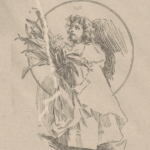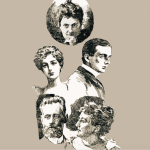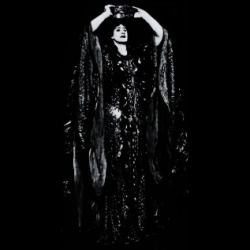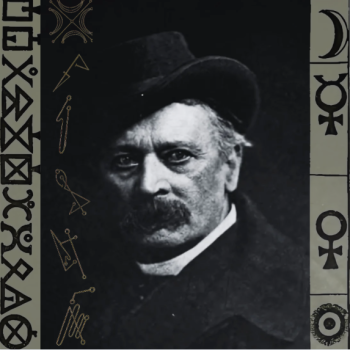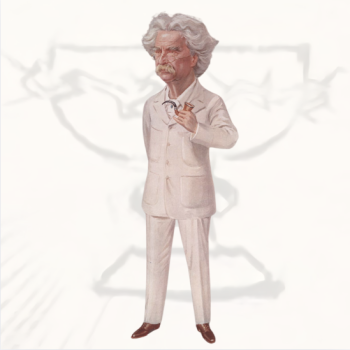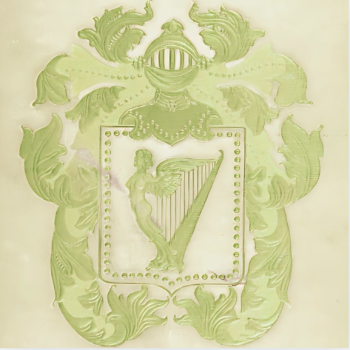A few days after the homecoming for the Theosophical Crusade at Madison Square Garden, on April 9, 1897, Minnie Neresheimer celebrated her birthday at the family home, on the shore of Little Neck Bay, near the Griscom home. The Neresheimer house was as beautifully decorated as the stage at the Garden, with palms, and cut flowers from the Emil’s private conservatory. The Guisemans Orchestra provided the musical entertainment.[1] Ernest, meanwhile, paid a visit to Aimée, and gave her the poetry he had written her. “Mr. Hargrove was very idealistic and, well, that was the way he made love to me,” Aimée would later say. [2] “[Ernest] and I used to take walks down to the bay and he used to tell me all about theosophy and expand my mind, talking about the universe.”[3] Ernest (in addition to his poetry and theosophical musings,) likely appealed to the heart of Aimée, a girl who dreamed of singing on the stage, with the mention that his father was one of the directors of the Carl Rosa Opera Company.[4] Ernest and Aimée were soon secretly engaged.
Under the pretense of attending the upcoming Convention of the Theosophical Society in Europe in August 1897, Aimée convinced her parents to travel to England, with Connie as her escort, and from there to Sweden. Aimée’s stay at the Hargrove family home in Marylebone was, in reality, an opportunity for Ernest’s parents to meet Aimée without causing suspicion. The plan was for Aimée and Connie to arrive in England in late May—just in time for Queen Victoria’s Jubilee festivities—and Ernest would join them two months later, in July, and together they would all leave for the Continent.
On May 19, 1897, Connie and Aimée arrived in Southampton, on the S.S. St. Paul.[5] The Hargrove home was busy with discussion that day. J. S. Hargrove, who was facilitating the bankruptcy of Oscar Wilde, and financial security of his client, Constance Wilde (née Lloyd.) Wilde had gone through something of a transformation. As the Pall Mall Gazette stated on May 19, “during the latter part of his hard labour, [Wilde] has been mainly occupied with the repairing and re-binding of the prison hymn books, books of Common Prayer, and Bibles.”[6]
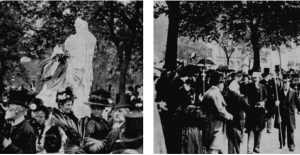
Unveiling the Siddons Statue.[7]
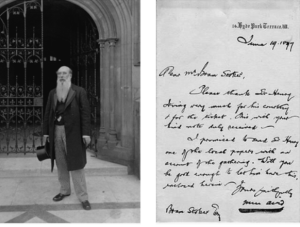
(Left) John Aird at the Parliament building, July 1897. (Right.) Letter From John Aird to Bram Stoker, June 19, 1897. (Right.)[8]
Connie’s uncle, John Aird, was having a warmer experience with the literary world. His friend, Bram Stoker, released Dracula a week after Connie and Aimée arrived. On June 18, Aird, together with his Masonic brothers, Henry Irving, and Bram Stoker, would attend the unveiling of the Sarah Siddons statue on the Paddington-green.[9] It was the first such statue of a non-royal woman to be erected in the city.[10] Connie and Aimée would certainly have attended, as Paddington-green was just a short walk from the Hargrove home at 25 Lancaster Gate.
Two days later, on June 22, the Queen’s Jubilee parade made an extended stop in Paddington where Aird delivered a speech.[11] Colonel Ludlow (Genevieve Griscom’s father,) representing the Americans in the parade of military attachés, was also at the Jubilee.[12] The annotation in Ludlow’s copy of The Secret Doctrine suggest he was reading that book at the time.
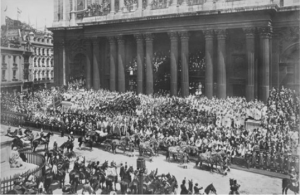
Diamond Jubilee.

William Ludlow’s copy of The Secret Doctrine at Harvard Library.
Meanwhile, back in the States, on July 5, 1897, the “Lotus Home for Children” was opened in Pleasant Valley, New Jersey, a five-minute walk from the 125 Street Ferry. It was envisioned as a Summer retreat for the poor children of the tenement-houses of the East Side (and their tired mothers.) Stabler was installed as the superintendent of the home. Ernest, A.H. Spencer, Emil, Marguerite Guild, John Pryse, and Tingley were in attendance. All of the talks spoke to the shared belief that the Lotus Home was “the beginning of a new era in the regeneration of society,” and “they prophesied that it would expand until it became one of the great institutions of the age.”[13] Ernest objected to the benevolent and practically philanthropic work which Tingley advocated and insisted on the “necessity of the propaganda being entirely ethical and spiritual.”[14] He would state this in the August 1897 issue of The North American Review, in his essay, “Theosophy And Ethics.”[15]
That summer Child Life debuted. It was a Theosophic magazine for all children aimed to bring out the idea of the importance of the first stages of child life as connected with all the other stages.[16] Because of the “rapid increase in circulation” of the magazine Theosophy/(Universal Brotherhood,) and The Theosophical News, The Theosophical Forum was deemed unnecessary and discontinued. The popular “Questions and Answers” portion of the Forum was folded into Universal Brotherhood.[17]
During this time, Tingley, Ernest, Emil, Spencer, and Pierce proceeded as stockholders in the West Virginia corporation for the S.R.L.M.A. Tingley was given six shares, while each of the other stockholders received a single share. (Spencer, being one of the greatest contributors to the fund, was the only stockholder known to have subscribed money towards the S.R.L.M.A.) Each of the stockholders immediately transferred their own stock to Tingley, who was still dissatisfied with her portion of the ownership. This transfer, however, was not entered upon the stock certificate book. Tingley was now the sole owner of the West Virginia corporation. The stockholders then elected Tingley for President of the corporation; Emil was elected Treasurer, and Tingley, Emil and Ernest were elected as Directors. Spencer was elected Secretary by the Board. E.B. Rambo, in whose name the Point Loma site was purchased, was then instructed to transfer the property to this new Corporation. The legality of this transfer of property, Ernest very much in doubted.[18] On July 14, Ernest sailed for England to join Aimée and his family.[19] On August 2, Ernest, Aimée and Connie, attended the Third Annual Convention of the T. S. E. (E.,) at the Hardman Assembly Rooms, in Liverpool, England. Arch was elected [President,] and Aimée read a greeting from Emil, and received “the heartiest of welcomes from the Convention.”[20]
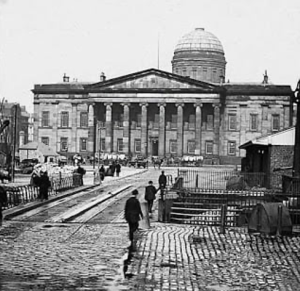
Liverpool, England c. 1890s.
From there Ernest escorted Aimée and Connie to the Convention in Stockholm, Sweden, where the Convention of the Theosophical Society in Europe was held in the Royal Academy of Science on August 8-9, 1897.[21] The majority of the Swedish members were present, in addition to Ernest, Connie and Aimée, there was a sizable number of foreign delegates. The work for the Scandinavian Movement had been carefully cultivated by Julia Keightley the previous year. Dr. Gustav Zander, the leader of the General Secretary of the Scandinavian Section, was recently elected President of the T.S. in Europe (Sweden,) and a new magazine, Theosophia, created by Carin Scholander, helped spread awareness of Theosophy in Sweden.[22] At the Convention, Zander read a telegram that the Theosophists received from King Oscar II of Sweden which conveyed his greetings and best wishes for the success of the Convention.[23]
The joy of the Convention would soon be eclipsed by the unexpected death of E.B. Rambo, the owner of Point Loma. Witnesses said that Rambo complained of feeling unwell at his California ranch on August 13. Three days later, after riding his bicycle to his work on in San Francisco, he collapsed and died. Jerome Anderson, Rambo’s physician, surmised that Rambo had a heart attack after cycling.[24] “Every Theosophist has lost a comrade, though the world has not lost its friend,” Ernest wrote, “for his heart was so full of gentle tenderness that the influence of his life on earth was at all times but the shadow of his influence in the world of the real.”[25]
While Ernest was away in Europe, Tingley was visited by Harry Parent, who was discharged from the navy on August 20, 1897.[26] During the visit Harry, who now went by the name “Henry Baron,” was looking through some papers in a desk at Tingley’s home on West End Avenue. He found an old clipping from one of the local papers that said that when “George W. Parent died, he left Harry George Parent $1,500 and a gold watch worth $1,000.” Henry asked Tingley what had become of the money, to which Tingley replied: “That woman got it all!” (by which she meant George Parent had given it to the woman he left Tingley for.) Henry then asked Tingley for papers relating to his parentage, but Tingley turned him away, saying that “they were in the bottom of a trunk,” and she “did not want to bother hunting for them.”[27]

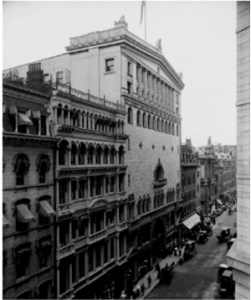
Tremont Temple.[28]
On August 31, 1897, A.H. Spencer wrote a letter to Ernest in which he described the meeting which the Directors of the S.R.L.M.A. had that day. It was the first meeting since the death of Rambo, and a preamble and resolutions were adopted in his honor. By this point, Ernest was entirely disillusioned with Tingley and her direction. On September 1, Ernest tendered his resignation as President to the Executive Committee. He claimed that his resignation was due to “serious financial events in America which [concerned him] intimately,” and he wished to devote his energies to the business world for the foreseeable future. Tingley, however, would not accept Ernest’s resignation until September 13, 1897, for she viewed 13 as an auspicious occult date, and “all big things are done on that date.” More likely, though, was the need of “one-upmanship,” on her part. In an E.S.T. circular Tingley sent out on September 3, 1897, she claimed that it was she who first suggested Ernest for President. “I knew at that crisis,” wrote Tingley, “he was the only available man to fill the place.” Ernest, outwardly at least, took it on the chin. Three days later, when giving an interview at the New England Theosophical Headquarters, Ernest stated, “Mrs. Tingley is so universally accepted among Theosophists as the leader of all Theosophical work, that opposition does not need consideration.”[29]
Besides a mounting suspicion of Tingley growing in Ernest, there was another reason for the resignation. On the voyage back from Europe, Ernest and Aimée made the decision to tell Emil of their plans for marriage. When the couple approached the Neresheimers with their news, however, Emil refused to give his consent. He said that Aimée, being only fifteen, was too young, and she did not have any schooling. Emil immediately sent Aimée to the Villa Maria School in Montreal—the same school from which Tingley had been expelled thirty years earlier.[30]
Ernest’s resignation was accepted at a special meeting called forth by Tingley on September 13, 1897. Tingley then intimated that she wished to see Emil installed as the President. “As her wish [was] as good as a command,” Emil dutifully complied. That same day Tingley sent two E.S.T. circulars. One of the circulars was about The International Brotherhood League, while the other, “The Theosophical Movement,” re-contextualized the history of the Society. The circulars were followed up with a published correspondence between Emil and Julia pertaining to the publishing department of the Society. Julia, unsurprisingly, championed Ernest’s cause, while Emil supported Tingley.[31] Knowing that knowledge of internal discord would cause harm to the movement in general, Ernest praised Tingley and Neresheimer in the press, and spoke of his confidence in their ability.[32] It was with a heavy heart that Ernest packed up his effects from his desk at 144 Madison—Judge’s desk. His new private office would be in the Griscom home, near the Griscom children who Judge loved.[33]
Anna Stabler was one of the first to sense the coming storm. On September 17, she stunned her fellow F.T.S. by declining to run for re-election as the branch President.[34] D.N. Dunlop, who relocated to New York around the time of the 1897 Convention, was “enthusiastically elected [President] by unanimous vote.”[35] Wright, Leoline, and Osmar moved to Mobile, Alabama, around the same time, distancing themselves from the movement.[36] Chapin followed Stabler’s lead and resigned as President of the Katherine Tingley Branch.[37] Chapin’s resignation letter was read before the Branch by her replacement, Herbert Crookes, on October 6, 1897.[38] Ernest, for the benefit of the Society’s integrity, did not immediately cease his involvement with Tingley. He was even a member of the Theosophical delegation at the Nashville Exposition held in late October 1897.[39]
Complaints were made, in New York at least, that the Theosophical Society no longer studied Theosophy. It had been converted into a “mere charitable organization.” Evidently the Masters agreed, for in November 1897, Ernest allegedly received notification from a new Outer Head who announced that Tingley was deposed, “owing to her serious misuse of the position entrusted to her.” Arch subsequently resigned the Presidency of the Theosophical Society in England, and the Presidency of the English E.S.T. Council. He continued to represent, in his words, the “original Society in England.” Tingley issued a new Esoteric Pledge which made significant alterations to the pledge which Blavatsky gave in Lucifer. Either Tingley no longer recognized the underlying principle of the pledge, or she could not afford to recognize the pledge without condemning herself.[40]
Blavatsky had warned of this moment in a letter which was read before the Boston Convention in April 1891: “The period which we have now reached in the cycle, that will close between 1897 and 1898, is, and will, continue to be one of great conflict and continued strain. If the Theosophical Society can hold through it, good; if not, while Theosophy will remain unscathed, the Society will perish—perchance most ingloriously—and the world will suffer.”[41] Theosophists could do very little to push back against the “Black Age,” the “Kali Yuga.” Judge stated as much, adding, “great forces are visibly increased at the close of certain cycles in the Kali Yuga. The present cycle, which closes Nov. 17th, 1897—Feb. 18th, 1898, is one of the most important of any that have been.”[42] With this knowledge in mind, Ernest composed an essay, “Priest And People,” set to be published in the December 1897, issue of The Arena. It read as a warning about the dangers of blind “hero worship” (presumably an allusion to Tingley.)[43]
Just as The Arena was set to hit the newsstands, the Hargrove-Griscom camp faced a tragedy unlike any they had yet experienced. Joyce Griscom “in some unaccountable manner…set fire to her clothing and was…enveloped in flames.” The injuries were fatal. Joyce had been playing with her toy piano when her nurse briefly left the child unattended to speak with Genevieve. The two women heard Joyce’s screams and raced to the room. Genevieve, who found Joyce’s dress in flames, seized a coat, and quickly wrapped it around her daughter. The fire was extinguished, but it was too late for Joyce. A doctor was sent for, but the child entered a coma and died not long after midnight on December 3, 1897. A message was sent to Clem’s office in Manhattan, and he arrived “almost crazed by grief to shore with the mother her awful load of anguish.”[44]
It would seem that the event had sufficiently shaken Ernest, for on December 11, 1897, he read a paper to a few friends, in which he stated that even if an office in Theosophical Society was offered to him, he could not accept it. For the benefit of the Society, Dr. Buck appealed to Ernest to reconsider occupying the office of President—this was under the presumption that the Convention would be held in April as it had been for over a decade—so Buck’s proposition was “preliminary and general.”[45] On December 15, 1897, the E.S.T. of the Outer Head connected with the Hargrove faction issued “Subsidiary Paper D,” (picking up from Judge’s Subsidiary Papers A, B, and C.) It commented on the law of cycles, on hierarchy, the Lodge, and the importance of meditation. The new Outer Head commented on the importance of the Pledge of the E.S.T. and used a quote a message received from one of the Masters.[46]
Aimée had returned home from Villa Maria for the holiday season, and Emil used this as an opportunity as leverage over Ernest. If Ernest refrained from issuing a circular regarding the pledge, than the couple would be allowed to wed. “I gave you my heart, but that was a figure of rhetoric,” Aimée told Ernest. “I cannot love you if you cannot be deferent to my father’s wish about the society. Now, all that you have to do in order that we may be happy is not to write a certain circular letter about Mrs. Tingley that is in your mind.” Emil’s plan did not work. “Ask me for all the vessels that have been sunk, in all the harbors—I will get them for you,” Ernest told Aimée. “Ask me to bring to you in a jewel casket made of a single ruby, the five pearls that the iron-beaked dove wore in the form of a star; ask that I cull for you every day for six months a 5-cents bunch of violets. These things are impossible, I will do them. But I cannot refrain from writing that circular.” The circular went out, and Aimée, heartbroken, was sent back to Villa Maria.[47] Ernest’s circular stated:
Any member of the Esoteric School of Theosophy who has taken a pledge to Mrs. Tingley personally, or to some alleged representative character, on the supposition that the taking of a personal pledge was directly or indirectly approved by the Master, is hereby notified that a pledge so taken is in no way binding, seeing that it was taken in ignorance of the facts…If the Higher Self has been invoked as a witness of a pledge, it is binding for life, if that pledge has been approved by the Higher Self, but not otherwise […] The Masters do not consider members of the Esoteric School of Theosophy to be bound by any alleged pledge, which has been given under an honest misapprehension of the facts; which is in any respect contrary in its letter or in its spirit to the truth, to the generally accepted moral law or to the law of the land […] No officer of the Esoteric School of Theosophy is or will be authorized by Masters to accept a personal pledge of obedience from any member under any circumstances.[48]
Echoes of internal strife had had reached the ears of the general membership in both of the Society, and of the E.S.T., yet Ernest was resolute in his decision not to run for office in the Society. He wrote to Dr. Buck on December 21, 1897, stating “that under no circumstances would [he] accept the office, giving [Dr. Buck] some of the reasons which would oblige [him] to decline.”[49]

Tingley, Aimée, Ernest, Emil, and Minnie.[50]
“I’m arranging a new society,” Tingley told the faithful. “It will be founded on principles that will admit only the most cultured. The first principle of this new organization will be implicit obedience to the Official Head.” Tingley had it all arranged to become the Official Head herself. She held this same position to be in the [Esoteric Section] up to the time she was evicted by the masters, and there also she demanded obedience. But it wasn’t always given, because the [Esoteric Section] is made up of the highest members of the Theosophical Society, who feel they are some pumpkins themselves. “Now there are some of you,” said Mrs. Tingley, “who will always show this obedience. There, for instance, is one man.” Here she pointed to an elderly person, the father of a large and interesting family, which is said to have driven him to Theosophy and other things. “That gentleman,” she continued, “would go down into the cellar of this house, and set it afire if I told him to do so. That’s the kind of Theosophist we want.” Then Tingley announced the name of this interesting, although possibly incendiary organization, would be the Universal Brotherhood. Collections were taken up, and in good faith many Theosophists joined, although openly declaring they would never become firebugs (arsonists,) even to please a Mahatma.[51]
On January 3, 1898, Fussell and other Tingley loyalists issued an unofficial “highly laudatory pamphlet” to members of the Society which detailed “the great works accomplished by Mrs. Tingley.” Tingley, meanwhile, had called representatives of the Society, from different parts of the United States to her home. There they drafted, and adopted, in secret, the Constitution of The Universal Brotherhood Organization and formed an oath-bound secret order, with herself as the supreme or head, “whose word is law and not a statute.” Her plan was to make the Theosophical Society a subsidiary organization of her own Universal Brotherhood at the upcoming Convention. Though this meeting was secret, an official public notice was issued, notifying the Society that the Convention, unconventionally, would not be held in April, but rather on February 18, 1898 at Chicago. Judge’s remarks about the closing of the cycle between November 17, 1897 to February 18th, 1898, must have seemed eerily accurate. On January 9, 1898, Ernest’s friends decided to nominate Ernest—to “run him,” as he said, “whether he liked it or not.” If they wanted to “run him” reasoned “it was their affair,” not his. Again, Ernest wrote to Dr. Buck to say that he had not changed his mind, nor determination, but, if anything, he could “be used as a temporary peg on which to hang a very important principle.” The pro-Ernest faction sent out a circular (without Ernest’s endorsement,) signed by Julia and others, dated January 17, 1898, soliciting signatures, and support, to elect Ernest as President at the upcoming Convention. Emil’s name was put forth as Treasurer, and, in a calculated attempt to keep the peace, suggested the revival of Blavatsky’s old position, Corresponding Secretary, for Tingley.[52] The circular stated:
To the branches and members of the Theosophical Society in America:
In order to give the members and branches as fair an opportunity as possible to consider what action they should take in connection with the election of officers at the forthcoming annual convention of the Theosophical Society in America—just announced to be held in Chicago in February—the undersigned submit for your consideration a list of well-known names and invite co-operation and support to secure their election:
For president, E.T. Hargrove. For vice-president, J.D. Buck. For treasurer, E.A. Neresheimer. For executive committee, J.D. Buck., A.P. Buchman, J.A. Anderson, E.A. Neresheimer, A.H. Spencer, W.M. Main.
It is proposed to create the title of corresponding secretary and elect Mrs. K.A. Tingley to that office, which was held for so many years by Mme. H.P. Blavatsky. We do not think it needful to commend these names to your favorable consideration, for they are as well known to each of you as they are to add that the interest and well-being of the society would be safe in such hands. We are pleased to be able to inform the members that the only reason stated by Mr. Hargrove for his resignation from the presidency last September—serious financial events in America which concerned him intimately—no longer exists, and there is every reason why he should be re-instated in the office he filled so well. Branches which desire to support these nominees are invited to so instruct their delegates. Branches which do not expect to be personally represented at the convention are asked to send their proxies to Dr. Buck, No. 124 West 7th St., Cincinnati, O. We are authorized to state that Dr. Buck and Buchman, and Messrs Spencer and Main would have signed this circular if their names had not appeared among those proposed for office.
The Tingleyites responded with a circular, signed by Emil, which disavowed any connection with the proposal, and reaffirmed their support for Tingley. Emil then presided over a meeting at Aryan Hall on January, 19, 1898, to discuss the matter of a circular. Tingley, who was present, stated that “she was directly opposed to political methods, and that she had a positive proof that some signatures to the opposition circular had been obtained under false pretenses.” Spencer requested that the contents of the circular be read, but he was voted down. When Dr. Thaddeus Hyatt admitted that he was one of the signers, he was prevented from speaking. After the meeting was adjourned, Tingley’s secretary, Elizabeth Churchill, demanded that Hyatt leave the room, “and an attempt was made to push him out.” On January 23, the Hargrovians re-issued their circular, signed by A.H. Spencer, disclaiming any intention of the original circular which may have suggested an endorsement by Tingley.[53]
On January 30, 1898, Ernest wrote to Tingley in which he quoted from the paper he wrote on December 11, 1897, which stated that he would refuse any T.S. office offered to him. Tingley refused to accept this from the “occult desperadoes,” by which she meant, Ernest and Clem. Tingley then received this note from Ernest:
Now my dear friend, you have made an awful mess of it—that is the simple truth. You were run in as [Outer Head] as the only person in sight who was ready to hand at the time. We were all of us heartily glad to welcome you, for you solved the problem which confronted us—who was to be O.H.; you were sort of neutral centre around which we could congregate. And most of us fairly yelled with delight, for you loved our difficulty and we had ample proofs that some members of the Lodge were working through you and that you had high and rare mediumistic and psychic gifts and that you were a disciple of the Lodge. So things went swimmingly for a time…Our enthusiasm, and anxiety to see all go well carried some of us too far—carried me too far to the extent of…leading me to use my personal influence with people to get them to accept you as O.H. I thought it was for the good of the work, but since then I have learned better.[54]
Another circular—undated—followed from the Hargrovians declaring that “serious and obvious defects exist in the management of the Society.” Without explicitly naming Tingley, their circular condemned the “overwhelming authority” exercised by the leaders of the Society:
The Annual Convention of the Society to be held in Chicago on February 18th and 29th, will be invested with a special importance and interest, both by reason of official announcement to that effect, and because there will come before it for consideration and decision, some of the vital problems of the Theosophical Movement, and the determination of the principles and methods by which the immediate future of the Society is to be controlled, and its activities guided. With such issues at stake, it is to be hoped that all who attend the Convention will do so in a spirit of genuine fraternity, openness of mind, and freedom from prejudice, and will exemplify, in voice and conduct, that tolerance for the opinions and motives of others that they expect and require for their own.[55]
Tingley then issued an E.S.T. circular, invoking the names of Blavatsky and Judge, which stated:
I have evidence from one or two places of absolute disloyalty to the Master and the School. Plans in embryo, indicating proposed action, which would be detrimental to the interests of the Theosophical Society, have come into my hand.[56]
In this circular Tingley provides the E.S.T. members an idea of what is in store at the upcoming February Convention. “Look for instructions which will open the door to those who wish to avail themselves of the opportunities of the new cycle, to be mailed on February 18, 1898, to Presidents of E.S.T. Groups for distribution to each Member.” The instructions were distributed, and members were told of a New Lodge being formed under her direction, and told them to be the “Guardians of the E.S.T.” It also contained a warning against the “few who are working adversely at the present time to the interests of the School.” Tingley adds, “When the report of the Convention of the Theosophical Society in America at Chicago shall have reached you, you will then better understand the deeper significance of one door closing and the other opening.”[57]
In the days leading up to the Convention, Emil received an anonymous letter which threatened him physical harm if should throw his support behind Ernest. “The letter was signed by some Hindoo name,” but many members believed that Ernest was the author. Once again, an anonymous letter was the source of the problem, just as it had been for Judge/Ganson letters in the autumn of 1894, of Claude in the summer of 1895, and Clem since his return from the Crusade. Ernest said that he would formally deny the authenticity of the letter, if Emil, or anyone in authority, would formally charge him with its composition. Emil, evidently, had sufficient enough doubt to make such a claim, and declined to make a charge. Henry B. Mitchell decided to get to investigate the allegation. He asked both Emil, and Jerome Anderson, what they thought about the letter. They would only confirm that the letter was real, and that it was anonymous., but beyond that nothing was certain.

“Fourth Convention Of The Theosophical Society In America After The Passing Of The Resolution.”[58]
Rumors were circulating that Ernest had consulted astrologers and palmists, who told him that Tingley would die before the Convention; others said that Ernest had been inspired by a “little Hindu,” said to be an adept in the philosophy of theosophy,” with the belief that, Henry Mitchell was to the new Outer Head, and “full heir to the mantle formerly worn by Blavatsky and William Q. Judge.” Ernest resolutely denied all such claims. ”It is a lie,” he said, “I am not in that kind of business. I do think I am possessed of some common sense, and am sorry that I am not given credit for it by my old friends of the society.” Henry simply laughed when he heard the news, and said that it explained why old acquaintances were giving him strange looks. “Why, I am not even an adept in Theosophy, let alone being possessed of this alleged influence.”[59]
There was a large, and enthusiastic, crowd at the Convention on February 18, 1898. The delegates from across the nation were given printed copies of the Resolutions, Preamble, and Constitution of the Universal Brotherhood. Of the 6,000 members present, only about 200 supported the Autonomists. With near unanimity, 95 percent of the membership adopted Tingley’s Resolutions which effectively turning surrendered the Theosophical Society to the Universal Brotherhood. Everything Judge had built up was now a mere “literary department” to a corporate body whose final authority was vested solely in Tingley.[60] “Our representatives were howled down at the convention,” A. H. Spencer stated, “and the resolution merging the T.S.A. into the Universal Brotherhood was rushed through without debate or discussion. The whole proceeding was revolutionary and without the slightest constitutional warrant.” Ernest’s account was similar:
[They] personally traduced, slandered, vilified, and in every conceivable way, misrepresented in more or less private gatherings by persons of whom it is hard to believe that some at least did not know the falsehood of that which they assisted in disseminating amongst a mass of excited and over credulous hearers, the minority would surrender the ark of their covenant and retire in sorrow and disgust.[61]
Immediately following the morning session, a meeting was held in the nearby Palmer House hotel, comprised of the delegates to the Convention “who could not be stampeded,” and who were denied any vote or hearing. In A.H. Spencer’s words:
After the convention, a number of us held a meeting at the Palmer House in Chicago and repudiated the action of the convention. We declared the whole thing null and void. Three members of our Executive Committee, and E.A. Neresheimer, voted for the resolution. We decided that by their revolutionary action they had vacated their offices in the T.S.A.[62]
Ernest called an E.S.T. meeting on February, 19, 1898, where he read a series of letters he wrote to Tingley from January 19, 1898 up to the date of the meeting, February 19. He also revealed what went on behind closed doors at the first meeting with Tingley on March 26, 1896, and fuller context regarding the course of events in the immediate aftermath of Judge’s death.[63] Clem, meanwhile, revived The Theosophical Forum, “the only obstacle to reviving it was the labour and expense its publication and distribution would involve. These Mr. Griscom himself assumed.” Dr. Buck was trying to get a permanent headquarters in Cincinnati in working order, and the temporary headquarters was moved to the St. Andrew’s Hotel on 72 and Broadway. This was ultimately a short-lived plan, and, once again, Mott Memorial Hall became the home of the Theosophical Society.[64] “If I did not make the mistake so many made at Chicago, it was because I had more ample opportunity of judging and knowing what was being done, and how false it was to every principle of theosophy and deliberately unjust and unbrotherly.” Said Dr. Buck. “I did not leave the platform at Chicago till this fact had been demonstrated.”[65] Though it is unclear how, Dr. Buck learned some damning evidence about Tingley and her relationship with the Masters. He subsequently sent a letter to Ernest which explained what he had learned. Then, on February 26, 1898, he sent a letter to Tingley which read:
I have resigned from that section of the E. S. T. over which you preside. This action was due to you no less than myself. Being no longer in sympathy with your methods, and my confidence in your direction being broken, I could not receive instruction or bestow obedience to any order of yours. You have converted the E. S. into a star-chamber, where insinuations and slander against Brothers is indulged in without protest, and where explanation or defense is not permitted. This I regard as not only unbrotherly, but as Jesuitical and cowardly. I think such methods demoralizing. I deny that they emanate from the Great Lodge and I believe they will rebound on all who participate in them.[66]
On Sunday, February 27, 1898, seventy-five members the (New York) Theosophical Society met in Mott Memorial Hall for what was described as an “informal conference” regarding the “Universal Brotherhood.” The meeting was called by A. H. Spencer. “[Tingley] has the power to appoint and displace at will all officers of the Theosophical Society in America,” said Spencer. “Why it’s not a constitution at all…it’s a recital, clause after clause of absolute power and dictatorship of Mrs. Tingley.” James H. Connelly, presiding as Secretary, next read Tingley’s constitution aloud—which caused a great deal of laughter. Ernest spoke against Tingley, so, too, did Colonel Ludlow, Julia Keightley, H.B. Mitchell, and even Ella Judge, Judge’s widow. Resolutions were then adopted repudiating the constitution of the Chicago convention, and declaring the Theosophical Society of America to be still in existence.[67]
Buck’s letter soon reached Ernest. It revealed that Tingley “had received her deposition from Koot Hoomi some time ago, but that she had surpassed the letter.” Buck’s letter claimed that when Tingley met the Masters in Darjeeling, they found her spiritual integrity lacking. Allegedly, when Tingley returned to America after the Crusade, she found the letter from the Masters notifying her that she was no longer their mouthpiece to world. Instead of resigning, Tingley, allegedly, hid all knowledge of the letter’s existence while continuing to masquerade as the Outer Head.[68]
On March 1, 1898, Ernest wrote a note to Tingley which declared: “You have ceased to be the Outer Head of the E.S.T. in the interior and true sense. You will, before long, cease to be the Outer Head of the school in the exterior sense. The Outer Head to follow you has already been appointed by the Master.” He then issued a twenty seven page pamphlet titled “E.S.T.” and mailed it to as many members as possible. This pamphlet was in the form of the “Minutes” of the E.S.T. meeting called by Ernest at Chicago on February, 19, 1898, where Ernest read the letters he sent to Tingley. The pamphlet also contained the full text of those letters with bracketed comments added by Ernest, as well as letters he sent to Tingley after the Convention up to February 25, 1898.[69] Three days later, on the evening of March 4, 1898, Ernest called another meeting at Mott Memorial Hall: “In a fevered, impassioned voice, [Ernest] related all that is told here—how Mrs. Tingley had pulled the wool over the sacred Mahatma eyes and was trying to hit the Theosophical Society a hard blow in the region of the watch-chain. As his authority [Ernest] gave the letter of Mr. Buck.”[70]
On March 13, 1898, The Sun printed Ernest’s open letter which announced that Tingley had ceased to be the agent of the Masters. “She has indulged in wholesale accusations and has been obliged to defend her action by lowering the ethical standard it was her duty to uphold.” Ernest’s letter, “being considered of extreme importance” would also be re-printed and forwarded to members of the global community. It said, in part:
Who deposed her? In occultism “men judge, condemn, and execute themselves.” Her own actions deposed her. The adepts made every possible effort to save her, but, as one of them wrote long ago, they, “bring? Along on the mighty tide (of life), can only modify and direct some minor currents.” Wise and great as they are, they are far from being omnipotent. When she had finally and hopelessly deposed herself they selected a new agent for the position of Outer Head of the Esoteric School which they founded. The work goes on unimpeded by many, and the adepts, instead of condemning Mrs. Tingley, stand ready to help her to the utmost extent of their ability and will never change their attitude in that respect. She tried to serve them; she did not really succeed. But they are deeply grateful to her for all her efforts, and they are informed the members of the “E.S.T.” that if they condemned her, or if they listen to evil said of her without protestation, it will be a violation of the principles of brotherhood and a breach of the rules of the school. It is sometimes necessary to present public acts of public persons in their true colors, or the official acts of officers; it is never necessary to condemn the persons or to impugn their motives.
“Those who seek the divine in all creatures will find the divine within themselves,” Ernest wrote in the closing remarks. “It is everywhere present, though difficult to discover. But he who seeks shall find. This is the statement of an occultist.”[71]
HARGROVE
I. “Refined English Atmosphere.”
II. “The Purple Mother.”
III. “Kitty Tingley, Despot.”
IV. “Villa Maria.”
V. “Dr. Leyds And The Occultation Of World Politics.”
VI. “The South African Situation.”
VII. “The Conciliator Of South Africa.”
VIII. “Transvaal Vs. Churchill.”
IX. “The Séances Of Thomas Welton Stanford.”
X. “The White Stag.”
XI. “The Hair Line Of Duty.”
SOURCES:
[1] “Mrs. E.A. Neresheimer’s Reception.” The Brooklyn Times-Union. (Brooklyn, New York) April 10, 1897.
[2] In the Matter of Proving the Last Will and Testament of Ernest Hargrove.
[3] “An Attorney Steals His Client’s Wife And In Turn Discards His Own.” The Fairmont West Virginian. (Fairmont, West Virginia) February 6, 1907.
[4] “Funeral Of Late Carl Rosa.” The Liverpool Mercury. (Liverpool, England) May 9, 1889.
[5] S.S. St. Paul. 19 May 1897. Southampton. The National Archives of the UK; Kew, Surrey, England; Board of Trade: Commercial and Statistical Department and successors: Inwards Passenger Lists.; Class: BT26; Piece: 115.
[6] “Oscar Wilde Released.” The Pall Mall Gazette. (London, England) May 19, 1897.
[7] “The Siddons Memorial.” Black And White. Vol. XIII, No. 333. (June 19, 1897): 767.
[8] John Aird to Bram Stoker, 19 June 1897. BC MS 19c Stoker, Bram Stoker correspondence and manuscripts (1847-1912) University of Leeds Special Collections, University of Leeds Libraries.
[9] “The Siddons Statue.” The Era. (London, England) June 19, 1897.
[10] Bullus, Claire & Ronald Asprey. The Statues of London. Merrell. London, England. (2009): 239.
[11] “The Queen’s Long Reign.” The Morning Post. (London, England) May 17, 1897; “Jubilee Day.” The Morning Post. (London, England) June 22, 1897.
[12] “Victoria’s Jubilee.” The Abbeville Press And Banner. (Abbeville, South Carolina,) July 7, 1897.
[13] “Mrs. Tingley’s ‘Lotus Home.’” The New York Times. (New York, New York,) July 4, 1897; “In The Household.” The Los Angeles Evening Express. (Los Angeles, California) July 31, 1897.
[14] “Theosophist Hargrove Weds.” The Kansas City Times. (Kansas City, Missouri) January 23, 1899.
[15] Hargrove, E.T. “Theosophy And Ethics.” The North American Review. Vol. CLXV, No. 489 (August 1897): 213-222.
[16] Hyatt, Elizabeth. “‘Child Life.” The Theosophical News. Vol. I No. 22. (November 16, 1896): 3.
[17] Neresheimer, E. A. “The Forum To Be Discontinued.” The Theosophical Forum. Vol. III, No. 4 (August 1897): 64; Mitchell, Henry Bedinger. “A Stone of the Foundation.” The Theosophical Quarterly. Vol. XVII, No. 1 (July 1919): 9-21.
[18] Hargrove, E.T. “Legal News.” The Theosophical Forum. Vol. IV. No. 1. (May 1898): 12-15.
[19] “Mirror Of The Movement.” Theosophy. Vol. XII, No. 5 (August 1897): 255-256.
[20] “Convention of the T.S.E. (England.)” The Irish Theosophist. Vol. V, No. 10 (July 15, 1897): 179-181.
[21] “Mirror Of The Movement.” Theosophy. Vol. XII, No. 5 (August 1897): 255-256; “Teosofkongress.” The Swedish Morgonbladet. (Stockholm, Sweden) August 9, 1897.
[22] J.W.L. Keightley. “Swedish Strength.” The Theosophical News. Vol. I, No. 28. (December 28, 1896): 2.
[23] Hargrove, E.T. “Mirror of the Movement.” Theosophy. Vol. XII, No. 7 (October 1897): 381-382.
[24] “Summoned To The Next Life.” The San Francisco Call. (San Francisco, California) August 17, 1897.
[25] Hargrove, E.T. “The Screen Of Time.” Theosophy. Vol. XII, No. 7 (October 1897): 375-380.
[26] New York State Archives; Albany, New York; Abstracts of Spanish-American War Military and Naval Service Records, 1898-1902; Series Number: B0809.
[27] “Discovery Of Henry Baron.” The Los Angeles Times. (Los Angeles, California) November 18, 1902.
[28] Detroit Publishing Co., Copyright Claimant, and Publisher Detroit Publishing Co. Tremont Temple, Boston. United States Boston Massachusetts, ca. 1900. Photograph. https://www.loc.gov/item/2016801549/.
[29] “Theosophy It Is.” The Boston Daily Globe. (Boston, Massachusetts) September 7, 1897; “Deserts Mahatma Kitty.” The Sun. (New York, New York) September 15, 1897; Hargrove, E.T. “The Screen of Time.” Theosophy. Vol. XII, No. 7 (October 1897): 375-380; “Mirror Of The Movement.” Theosophy. Vol. XII, No. 7 (October 1897): 381-384.
[30] Congrégation de Notre-Dame Register of Students: 1893-1916 (326.000.445). Canada, Montréal. Aimée attended the “cours supérieur” during the 1897-1898 academic year and the “cours sous-gradué” briefly during the 1898-1899 academic year; “Mysteries Of Tingleyism.” The Sun. (New York, New York) November 8, 1902; In the Matter of Proving the Last Will and Testament of Ernest Hargrove.
[31] The Theosophical Movement: 1875-1925. E.P. Dutton & Company. New York, New York. (1925): 675.
[32] “Mr. Hargrove’s Resignation.” The Daily Tribune. (New York, New York) September 19, 1897.
[33] “Mrs. Tingley Makes Answer To Enemies.” The San Francisco Call. (San Francisco, California) September 10, 1899; Mitchell, Henry Bedinger. “A Stone of the Foundation” The Theosophical Quarterly. Vol. XVII, No. 1 (July 1919): 9-21; Hargrove, Ernest Temple. “Letters From W.Q. Judge II.” The Theosophical Quarterly. Vol. XXIX, No. 1. (July 1931): 35-44.
[34] “Mr. Hargrove’s Resignation.” The Daily Tribune. (New York, New York) September 19, 1897.
[36] National Archives and Records Administration; Washington, DC; NAI Title: Index to Petitions for Naturalizations Filed in Federal, State, and Local Courts in New York City, 1792-1906; NAI Number: 5700802; Record Group Title: Records of District Courts of the United States, 1685-2009; Record Group Number: RG 21.
[37] “Theosophical Societies.” New Century. Vol. I, No. 3. (October 14, 1897): 8.
[38] “Theosophical Societies.” New Century. Vol. I., No. 3. (October 14, 1897): 8.
[39] “Theosophists Are Through.” The Tennessean. (Nashville, Tennessee) October 19, 1897; E.A. Neresheimer. “Nashville Exposition: Theosophists’ Congress.” New Century. Vol. I., No. 5 (October 28, 1897): 8-16.
[40] “Theosophists All Awry.” The Sun. (New York, New York) December 28, 1897; Hargrove, E.T. “Adepts Shunt Mrs. Kitty.” The Sun. (New York, New York) March 13, 1898; The Theosophical Movement: 1875-1925. E.P. Dutton & Company. New York, New York. (1925): 675.
Hargrove, E.T. “Obituary: Archibald Keightley.” The Theosophical Quarterly. Vol. XXVIII, No. 3 (January 1931): 289-293.
[41] “Age Of Strife.” The Boston Globe. (Boston, Massachusetts) April 27, 1891.
[42] Niemand, Jasper (compiler) Letters That Have Helped Me Vol. II. The Quarterly Book Department. New York, New York (1918): 49.
[43] Hargrove writes: No priest to dictate to you the path you should tread; only your own soul’s light to guide you. Spiritual teachers, if you can find them, whose function it will be, not to drag you out of hell or up into heaven, but to educate you religiously by “leading forth” all that is best and highest in your nature. And in dealing with these, your priests—human, and therefore liable to err as the greatest of them must be—remember your own responsibilities. You may make them what you would have them be. In your hands is the power, for priests cannot exist without you, are dependent upon you for their very labors. Use the power that is yours fearlessly and for the good of all. Demand the best, and let your demands be made known to them; they will, for they must, supply what you demand. Loyalty to your religion and your church should make this binding upon you ; loyalty to your teachers themselves makes it necessary. Dare, and dare yet again — then reap your reward and see others reap it with you. Do not reverence anyone for the mere position he may occupy; respect the position, but reverence in him only that which partakes of the divine, that which you recognize as worthy of imitation.” [Hargrove, E.T. “Priest And People.” The Arena Vol. XVIII, No. 97 (December 1897): 772-787.]
[44] “Death From Burns.” The Brooklyn Times-Union. (Brooklyn New York) December 3, 1897; “Death Hid In The Stove.” The World. (New York, New York) December 3, 1897; “Mr. Griscom’s Daughter Burned.” The Sun (New York City) December 4, 1897; “Mrs. Tingley Makes Answer To Enemies.” The San Francisco Call. (San Francisco, California) September 10, 1899.
[45] “Minutes.” The Theosophical Forum. Vol. III, No. 5. (February 1898): 14-22.
[46] Cooper, John. “The Esoteric School Within the Hargrove Theosophical Society.” Theosophical History. Vol. IV, No. 6-7. (April 1993-July 1993):178-186.
[47] Bond Of Theosophy.” The New York Journal. (New York, New York) January 18, 1899.
[48] “Bond Of Theosophy.” The New York Journal. (New York, New York) January 18, 1899.]
[49] “Minutes.” The Theosophical Forum. Vol. III, No. 5. (February 1898): 14-22.
[50] [Tingley] “Says She Brings An Olive Branch.” The New York Journal. (New York, New York.) March 19, 1897; [Emil] “High Priest Of Theosophy.” The Los Angeles Express. (Los Angeles, California) October 11, 1897; [Minnie] “Plucky Woman Resists Robbery.” The New York Journal. (New York, New York), December 22, 1896; [Ernest and Aimée] “Bond Of Theosophy.” The New York Journal. (New York, New York), January 18, 1899.
[51] “Mrs. Tingley Deposed.” The World. (New York, New York) March 5, 1898.
[52] “Theosophists All Awry.” The Sun (New York, New York) December 28, 1897; “Another War.” The Boston Globe. (Boston Massachusetts) January 20, 1898; “Spoke Against Mrs. Tingley.” The Boston Globe. (Boston, Massachusetts) February 28, 1898; “Minutes” The Theosophical Forum Vol. III. No. 5. (February, 1898): 14-22; Olcott, H.S. “Old Diary Leaves: Sixth series, Chapter XX” The Theosophist Vol. XXVII., No. 11 (August, 1906): 801-811; The Theosophical Movement: 1875-1925. E.P. Dutton & Company. New York, New York. (1925): 675-676.
[53] The Theosophical Movement: 1875-1925. E.P. Dutton & Company. New York, New York. (1925): 676.
[54] “Minutes.” The Theosophical Forum. Vol. III, No. 5. (February 1898): 14-22; Olcott, H.S. “Old Diary Leaves: Sixth series, Chapter XX.” The Theosophist. Vol. XXVII, No. 11 (August 1906): 801-811; The Theosophical Movement: 1875-1925. E.P. Dutton & Company. New York, New York. (1925): 679-680.
[55] Kenneth R. Small Archive of the Universal Brotherhood and Theosophical Society at Lomaland, 1874-1960. Special Collections & University Archives. San Diego State University. Series 4: E.S.—Esoteric Section. Folder 4: Eastern School of Theosophy—American Section (Hargrove/Mrs. Griscom), 1898-1906.
[56] The Theosophical Movement: 1875-1925. E.P. Dutton & Company. New York, New York. (1925): 676.
[57] The Theosophical Movement: 1875-1925. E.P. Dutton & Company. New York, New York. (1925): 677.
[58] “Fourth Convention Of The Theosophical Society In America After The Passing Of The Resolution.” The Century Path. Vol. I, Nos. 21 & 22 (March 5, 1898): 12.
[59] Mitchell, Henry Bedinger. “A Stone of the Foundation.” The Theosophical Quarterly Vol XVII No 1 (July, 1919): 9-21; “Wears The Crown.“ The Inter-Ocean. (Chicago, Illinois) February 20, 1898; “Minutes” The Theosophical Forum. Vol. III, No. 5 (February, 1898): 14-22; “Clash In Sect.” The Chicago Tribune. (Chicago, Illinois) February 20, 1898.
[60] “Kitty Tingley, Despot.” The Sun. (New York, New York) February 28, 1898; The Theosophical Movement: 1875-1925. E.P. Dutton & Company. New York, New York. (1925): 677-678.
[61] E.T.H. “Legal News” The Theosophical Forum. Vol. IV. No. 1. (May, 1898): 12-15.
[62] “Kitty Tingley, Despot.” The Sun. (New York, New York) February 28, 1898.
[63] The Theosophical Movement: 1875-1925. E.P. Dutton & Company. New York, New York. (1925): 679-680.
[64] Spencer, A.H. “Official Notice.” The Theosophical Forum. Vol. III, No. 5. (February, 1898): 1-2; “Theosophical News And Work.” The Theosophical Forum. Vol. IV, No. 1. (May, 1898): 11; Mitchell, Henry Bedinger. “A Stone of the Foundation.” The Theosophical Quarterly. Vol XVII, No 1 (July 1919): 9-21.
[65] “Inside Facts Concerning The Dream City Of Estero.” The San Francisco Call. (San Francisco, California) August 5, 1900.
[66] Olcott, H.S. “Old Diary Leaves: Sixth Series: Chapter XX” The Theosophist. Vol. XXVII., No. 11 (August 1906): 801-811.
[67] “Kitty Tingley, Despot.” The Sun. (New York, New York) February 28, 1898; “Spoke Against Mrs. Tingley.” The Boston Globe. (Boston, Massachusetts) February 28, 1898.
[68] “Mrs. Tingley Deposed.” The World. (New York, New York) March 5, 1898.
[69] The Theosophical Movement: 1875-1925. E.P. Dutton & Company. New York, New York. (1925): 679-680.
[70] “Mrs. Tingley Deposed.” The World. (New York, New York) March 5, 1898.
[71] E.T. Hargrove. “Adepts Shunt Mrs. Kitty.” The Sun. (New York, New York) March 13, 1898.


